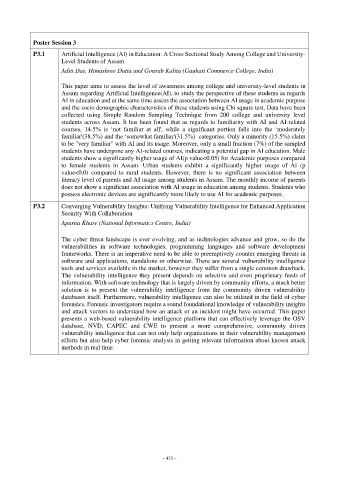Page 517 - Kaleidoscope Academic Conference Proceedings 2024
P. 517
Poster Session 3
P3.1 Artificial Intelligence (AI) in Education: A Cross Sectional Study Among College and University-
Level Students of Assam
Aditi Das, Himashree Dutta and Gourab Kalita (Gauhati Commerce College, India)
This paper aims to assess the level of awareness among college and university-level students in
Assam regarding Artificial Intelligence(AI), to study the perspective of these students as regards
AI in education and at the same time assess the association between AI usage in academic purpose
and the socio demographic characteristics of these students using Chi square test. Data have been
collected using Simple Random Sampling Technique from 200 college and university level
students across Assam. It has been found that as regards to familiarity with AI and AI-related
courses, 14.5% is ‘not familiar at all', while a significant portion falls into the ‘moderately
familiar'(38.5%) and the ‘somewhat familiar'(31.5%) categories. Only a minority (15.5%) claim
to be "very familiar" with AI and its usage. Moreover, only a small fraction (7%) of the sampled
students have undergone any AI-related courses, indicating a potential gap in AI education. Male
students show a significantly higher usage of AI(p value<0.05) for Academic purposes compared
to female students in Assam. Urban students exhibit a significantly higher usage of AI (p
value<0.0) compared to rural students. However, there is no significant association between
literacy level of parents and AI usage among students in Assam. The monthly income of parents
does not show a significant association with AI usage in education among students. Students who
possess electronic devices are significantly more likely to use AI for academic purposes.
P3.2 Converging Vulnerability Insights: Unifying Vulnerability Intelligence for Enhanced Application
Security With Collaboration
Aparna Khare (National Informatics Centre, India)
The cyber threat landscape is ever evolving, and as technologies advance and grow, so do the
vulnerabilities in software technologies, programming languages and software development
frameworks. There is an imperative need to be able to preemptively counter emerging threats in
software and applications, standalone or otherwise. There are several vulnerability intelligence
tools and services available in the market, however they suffer from a single common drawback.
The vulnerability intelligence they present depends on selective and even proprietary feeds of
information. With software technology that is largely driven by community efforts, a much better
solution is to present the vulnerability intelligence from the community driven vulnerability
databases itself. Furthermore, vulnerability intelligence can also be utilized in the field of cyber
forensics. Forensic investigators require a sound foundational knowledge of vulnerability insights
and attack vectors to understand how an attack or an incident might have occurred. This paper
presents a web-based vulnerability intelligence platform that can effectively leverage the OSV
database, NVD, CAPEC and CWE to present a more comprehensive, community driven
vulnerability intelligence that can not only help organizations in their vulnerability management
efforts but also help cyber forensic analysts in getting relevant information about known attack
methods in real time.
– 473 –

